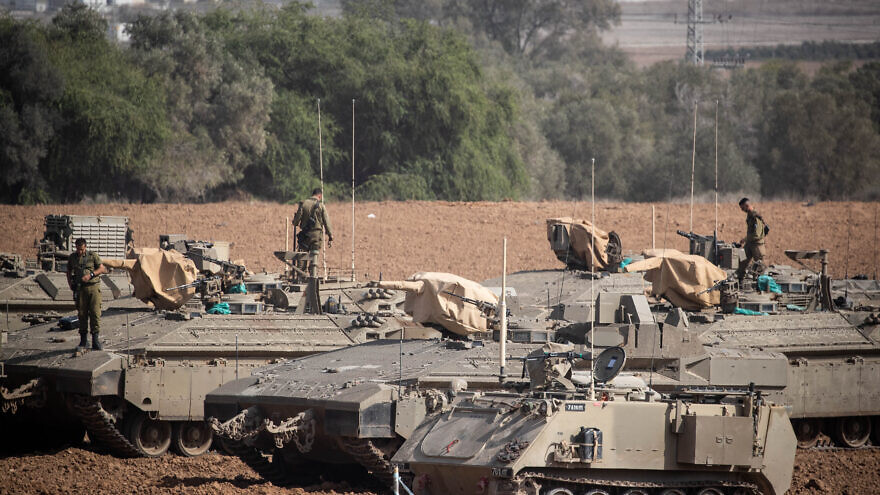Israel carefully managed its second day of conflict with Palestinian Islamic Jihad (PIJ) on Wednesday, keeping airstrikes focused on the suppression of Gazan rocket-launch squads, as Hamas, despite declarations, continued to sit on the sidelines.
As Israel sought to contain the escalation, a fragile situation emerged that could easily and dramatically change due to any significant civilian casualty on either side.
In its effort to kill Israeli civilians in revenge for the Tuesday-morning precision strike on Gazan terror chief Baha Abu al-Ata, PIJ fired more than 360 rockets throughout Tuesday and Wednesday combined, targeting Israeli cities and towns.
On Wednesday night, rocket salvos targeted the large coastal city of Ashdod, south of Tel Aviv. The Iron Dome air-defense system intercepted more than 90 percent of rockets heading to built-up areas, according to Israel Defense Forces’ figures. One woman sustained moderate injuries in a rocket strike in Ashkelon on Wednesday, and cars narrowly escaped destruction on an Israeli highway that was hit by a Gazan rocket on Tuesday.
‘This is where things should end’
The Israel Air Force demonstrated its ability to hit time sensitive targets in Gaza effectively, detecting and neutralizing several rocket-launch crews in real time in the middle of their operations.
Some 20 terror operatives were killed in Israeli strikes, according to the IDF. Most Gazan casualties were active combatants, stressed Conricus. Responding to reports of civilian casualties as well, he added, “We make very many efforts so that the only casualties are terrorists.”
As Hamas chose to stay out of hostilities for a second consecutive day, the IDF, for its part, stuck to its game plan of trying to prevent a wider escalation by keeping the combat with PIJ only.
“We set out to take out a terrorist who presented a threat and was on the way to carrying out more attacks against Israel,” said Conricus, referring to Abu al-Ata. “He was the target, and he was surgically eliminated. This is where things can and should end.”
Hamas, for its part, viewed al-Ata as a major troublemaker who undermined efforts led by Egypt to reach more stable truces in Gaza and help find new relief for Gaza’s failing economy.
Although it issues messages of support, as of Wednesday evening Hamas played no active role in attacks on Israel. As Hamas and Israel avoided attacks on one another, the gap in interests between Hamas and PIJ became apparent to all.
Yet the unpredictable nature of such flare-ups mean that Hamas could be pulled in at any time should PIJ insist on continuing to terrorize Israeli civilians with projectile fire.
Earlier on Wednesday, Israeli aircraft struck and destroyed a key rocket-warhead manufacturing facility in southern Gaza, where the IDF said raw materials were used for making long-ranged rockets.
The PIJ’s domestic-weapons production network is what keeps its rocket inventory full; the organization is estimated to have an arsenal larger than that of Hamas. Collectively, both terror groups have in excess of 20,000 rockets.
PIJ’s production array “consists of a number of sites throughout the Gaza Strip, each relying on one or more of the steps required in the rocket-manufacturing processes: production of raw rocket materials, lathing of metal components, computing, electronics and final assembly,” the IDF said in a statement. “The Islamic Jihad invests heavily in the infrastructure and resources it uses in the rocket-production system, which is considered to be a crucial component in strengthening its organizational capabilities.”
Additional Israeli strikes hit the organization’s Khan Yunis headquarters in southern Gaza and other weapons’ storage facilities.
During the combat, IDF Chief of Staff Lt. Gen. Aviv Kochavi visited the military’s Gaza Division, meeting with local commanders and conducting a situation assessment with them. He heard about an assortment of PIJ threats, including anti-tank and sniper fire, and steps taken by the military to counter them.
For the first time, a Gazan conflict wholly excluding Hamas has raged for two days between Israel and PIJ, and the situation appeared to approach a fork in the road. With one path leading to further escalation and the second to a return to quiet—this time without the explosively dangerous presence of Abu al-Ata—the coming hours look to be decisive in determining the next stage of this escalation.


























